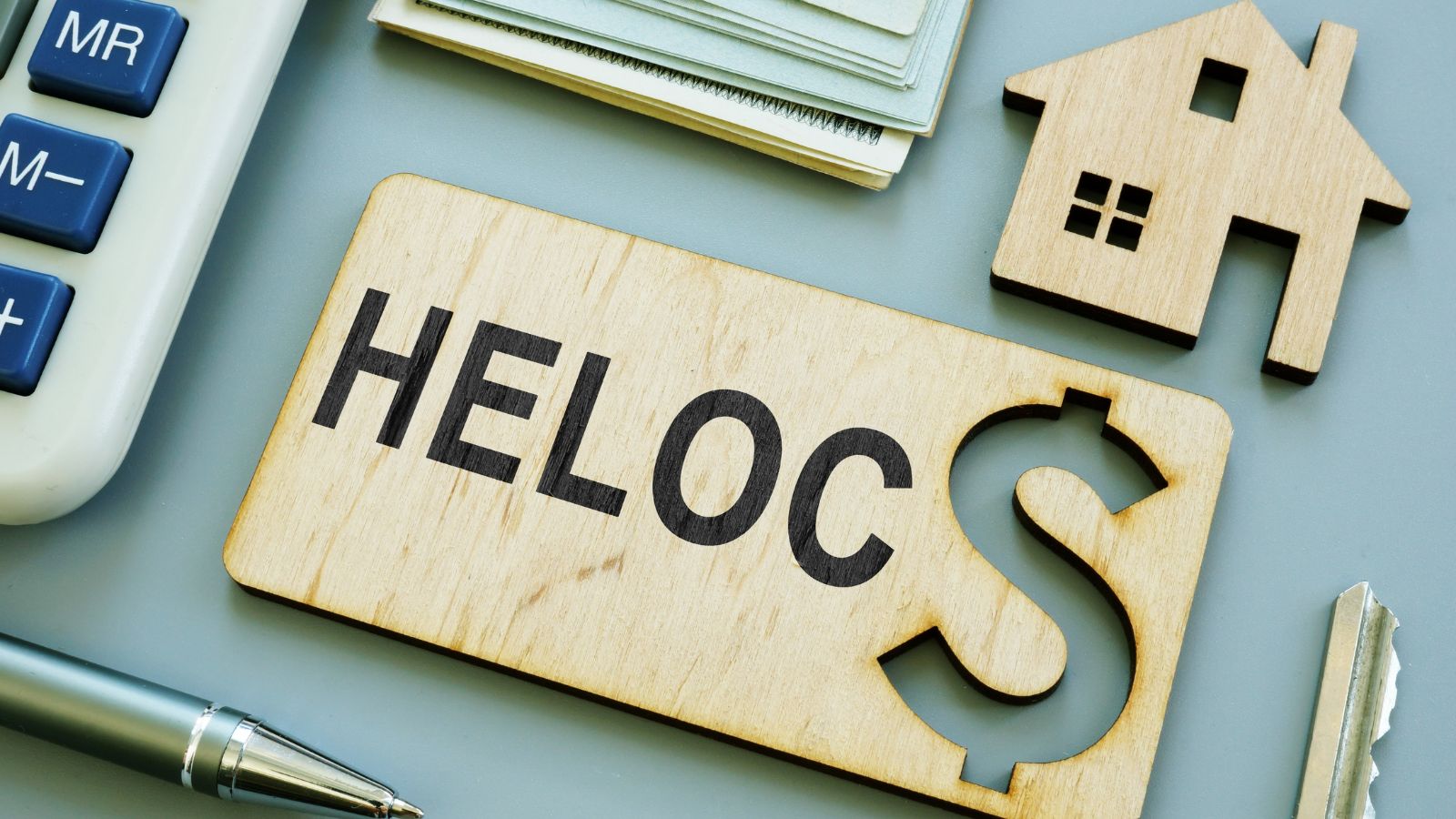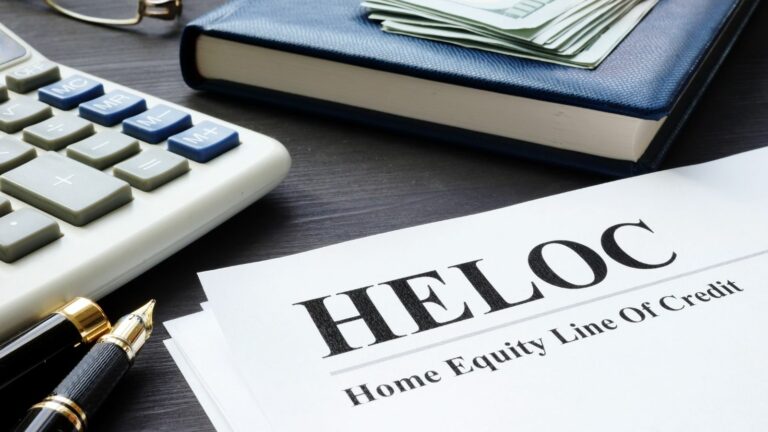A Home Equity Line of Credit provides many homeowners with financial flexibility, but when it comes time to sell, it can raise many questions and uncertainties. Can you sell your home with a HELOC still on it? How does it affect the selling process? With a surge in homeowners tapping into their equity, these questions have become more prevalent. This guide provides clear, concise answers, ensuring you know how to make informed decisions during your home sale.

Demystifying HELOCs: Everything You Need to Know Before Selling
The Ins and Outs of a HELOC:
A Home Equity Line of Credit, frequently known as a HELOC, is a flexible financial tool allowing homeowners to borrow against the equity they’ve built in their property. Think of it as a revolving credit account: it lets you draw on a set amount based on the value of your home, minus any outstanding mortgages.
Equity Defined: Equity represents the gap between your property’s present market value and what you still owe on your mortgage. If your home is worth $300,000 and you owe $200,000, your equity is $100,000.
Credit Limit: The lender determines your HELOC credit limit by taking a percentage of your home’s appraised value. You then subtract the amount owed on your existing mortgage from this figure. For instance, if a lender offers 85% loan-to-value and your home is appraised at $300,000 with a remaining mortgage of $200,000, your maximum credit line will be $55,000 (85% of $300,000 is $255,000 minus $200,000).
Variable Interest Rates: Unlike fixed-rate home equity loans, most HELOCs have variable interest rates. This variable means the interest you owe can fluctuate based on market conditions.
The Borrowing Period (Draw Period)
Every HELOC has a draw period when you can actively borrow against the equity line.
Duration: Typically, this period lasts between 5 to 10 years, depending on the terms set by your lender.
Access to Funds: You can draw money as needed, up to the limit of your credit line, similar to how you’d use a credit card.
Payments: During the draw period, many HELOCs will allow you to make interest-only payments, providing flexibility in managing your monthly financial commitments.
The Repayment Period
Following the draw period, you enter the repayment phase.
Duration: This can range anywhere from 10 to 20 years.
Payments: Here, you’ll begin to pay back the principal (the amount borrowed) and the interest, which means your monthly payments will increase compared to the draw period.
No New Borrowing: You can’t borrow further from the HELOC during this phase.
Differences between a HELOC and a Home Equity Loan
While both these financial tools let homeowners tap into their equity, they function quite differently.
How You Get the Money: A HELOC gives you a credit limit from which you can borrow as needed, whereas a home equity loan provides a lump sum amount right at the outset.
Interest Rates: HELOCs typically come with variable rates, while home equity loans often have fixed rates.
Repayment: With a home equity loan, you’ll make fixed payments over a set term. With a HELOC, repayment can be more flexible during the draw period, shifting to more structured payments during the repayment phase.
Why Homeowners Opt for a HELOC
There are various reasons a homeowner might decide to open a HELOC.
Home Improvements: Many use it to finance renovations or repairs, which can further increase the property’s value.
Debt Consolidation: It can be a tool to consolidate higher-interest debts, like credit card balances, into a single, lower-interest payment.
Education: Some homeowners might tap into their equity to pay for education expenses for themselves or family members.
Emergencies: Given its flexibility, a HELOC can serve as an emergency fund for unexpected expenses, from medical bills to job losses.
Understanding the core concepts of a HELOC is vital, especially if you’re considering selling your home. It ensures you can navigate the process confidently and make decisions in your best financial interest.
Untangling the Ties: Selling Your Home with a HELOC in Place
When you take out a HELOC, the bank or lender places a lien on your property. A lien is a legal claim or a “right” on some property granted to a creditor as a security for a debt or charge. In the case of a HELOC, the lender has a legal right to a portion of your property’s value until you repay the borrowed amount. The lien ensures the lender gets paid back before you can fully transfer ownership when selling. If you sell your home without settling the HELOC, the debt remains active; the lien stays in place, and the sale proceeds go to the lender.
Selling a house with an active HELOC might seem daunting, but understanding the steps can demystify the process. As you progress through the sale, you’ll work closely with your real estate agent and the lender to ensure that all parties involved are satisfied. Key steps include ensuring that the potential buyer is aware of the HELOC. Full transparency will ensure smoother negotiations and prevent any last-minute surprises.
When you collaborate with the lender, they inform you about handling the HELOC during the sale, whether you should pay it off with the sale proceeds or make other arrangements. An escrow service can manage the funds from the sale, ensuring that the HELOC is paid off first, with the remaining balance then directed to you.
Once you complete the sale, you must settle the HELOC. Here’s the typical sequence: First, use the sale proceeds to pay off any outstanding balance on the primary mortgage. Then, you use the remaining funds to settle the HELOC. Next, you’ll use the remaining funds to pay the HELOC. If any funds remain after settling these debts, you can keep them.
A Glimpse into Reality: A Case Study on Selling with a HELOC
Meet Jane, a homeowner with a house valued at $400,000. She owes $200,000 on her primary mortgage and has taken out a HELOC of $50,000. When Jane decides to sell her home, she finds a buyer willing to purchase it for the full asking price. After finalizing the sale, Jane paid off her primary mortgage, leaving $200,000. She then settles the HELOC, which reduces her funds to $150,000. Once she accounts for real estate agent fees and other closing costs, Jane walks away with a substantial sum, free from her mortgage and HELOC obligations.
Balancing the Scales: Benefits and Challenges of Selling with a HELOC
Tapping into Home’s Appreciated Value: Over time, the value of many homes increases. If your property’s worth has increased since you took out your HELOC, selling it could mean you’ll benefit from this appreciation, using the extra value to pay off the HELOC and potentially making a profit.
Consolidation of Debts: Selling a home can provide the opportunity to gather enough funds to settle the HELOC and pay off other debts. By consolidating and eliminating various liabilities, you simplify your financial situation, potentially saving on interest and reducing financial stress.
Financial Flexibility: Once you sell your home and settle the HELOC, you might be more comfortable financially. Without monthly HELOC payments, you can allocate funds to other areas of your life, whether investing, saving, or spending on things you’ve long desired.
The Need for Sufficient Sale Proceeds: One of the primary concerns when selling with a HELOC is ensuring that the sale price covers the primary mortgage and the HELOC amount. If the proceeds from the sale aren’t enough, you’ll need to find other means to settle the remaining balance.
The Impact of Market Conditions: The real estate market is dynamic and can fluctuate based on numerous factors. If the market takes a downturn when you’re looking to sell, the value of your home has decreased, making it challenging to cover both your mortgage and HELOC.
Potential Misunderstandings with Buyers: Some buyers might not be familiar with the intricacies of purchasing a home with a HELOC in place. There could be misconceptions or concerns, requiring additional effort to clarify and assure potential buyers that the property transfer will be seamless.
By understanding the advantages and the challenges, homeowners can make informed decisions when considering selling a property with a HELOC. Proper planning, consultation with real estate professionals, and clear communication with potential buyers can further streamline the process.

Navigating the Sale: Tips and Best Practices for Homeowners with a HELOC
Being Transparent with Potential Buyers: Honesty is always the best policy. When selling a home with an active HELOC, it’s essential to disclose this to potential buyers. This openness can prevent misunderstandings, foster trust, and ensure a smoother transaction process.
Consulting with Financial Advisors or Real Estate Agents: Knowledge is power. By engaging experts like financial advisors or real estate agents, you can gain insights into market trends, receive advice tailored to your financial situation, and get answers to any HELOC-related questions. Their expertise can be invaluable in navigating the sale process with a HELOC in play.
Reviewing HELOC Terms with Your Lender: Before putting your house on the market, sit down with your lender to discuss the terms of your HELOC. This meeting can clarify any prepayment penalties, the total outstanding amount, and other vital details. Being informed ensures you know what to expect when it comes time to sell.
Ensuring Clarity on Final Payout Figures: After consulting your lender, but before finalizing the home sale, ensure you clearly understand the final payout figures. Knowing the exact amount needed to clear your HELOC and other potential fees ensures there are no surprises at closing.
Planning for the Closing Process: The closing process can be intricate, especially with a HELOC involved. Work alongside your real estate agent to put all required documents in order, inform all parties, and allocate funds appropriately to settle the HELOC. Proper planning reduces the likelihood of last-minute hitches and ensures a seamless transaction.
By following these tips and best practices, homeowners with a HELOC can confidently navigate the home selling process, meet all financial obligations, and ensure a smooth sale progression.
Exploring Other Avenues: Refinancing or Rolling Over the HELOC
Refinancing Defined and its Connection to HELOCs: Refinancing your home mortgage means replacing your current loan with a new one, typically with different terms or interest rates. Regarding HELOCs, refinancing can help homeowners secure better interest rates or consolidate multiple loans into one, potentially simplifying their financial landscape.
Benefits of Refinancing Your Home Before Selling: Opting to refinance before selling can offer several advantages. These include securing a lower interest rate, reducing monthly payments, or transitioning from a variable-rate HELOC to a fixed-rate loan. By improving loan terms, homeowners can increase their home’s profitability upon sale.
Rolling Over a HELOC into a New Mortgage: Some homeowners choose to move it into a new mortgage instead of settling a HELOC during a home sale. This process involves combining the remaining HELOC balance with a new home loan, usually for a property they’re purchasing after the sale. Managing debts while transitioning to a new home can be a strategic move.
Determining if Refinancing or Rolling Over is Right for You: Both refinancing and rolling over a HELOC have their merits, but the best choice depends on individual circumstances. Homeowners should assess their financial position, long-term goals, and market conditions. Consulting with financial professionals can also provide clarity, helping homeowners make the most informed decision.
By understanding refinancing and rolling over a HELOC, homeowners can better assess their options and choose the path that best aligns with their financial and personal goals.
Tackling Common Queries: Addressing Frequently Asked Questions
What Happens If the House Doesn’t Sell for Enough to Cover the HELOC?
If your home sells for a price that doesn’t cover the outstanding HELOC balance, you’ll still be responsible for repaying the remaining amount. In such scenarios, you can discuss options with your lender, such as setting up a repayment plan for the leftover balance.
Can I Transfer My HELOC to a New Property?
Typically, lenders link HELOCs to the property that homeowners use as collateral when establishing the line of credit. If you sell that home, the HELOC usually needs to be settled. However, you can always apply for a new HELOC on your next property, given that you meet the lender’s qualifications.
How Will the HELOC Affect My Credit Score During the Selling Process?
Selling your home and settling the HELOC can affect your credit score. If you pay off the HELOC promptly and in full, it can positively impact your score. However, late payments or carrying a significant balance relative to your credit limit can negatively affect your credit. Always ensure timely communications with your lender to mitigate potential negative impacts.
Is It Possible to Sell a Home with Multiple HELOCs or Liens?
Selling a property with multiple HELOCs or other liens can be more complex. Before transferring the property’s clean title to the new owner, you must settle all liens against the property, whether from HELOCs, primary mortgages, or other debts. In such situations, working closely with a real estate attorney or a seasoned agent is crucial to navigate the intricacies.
By addressing these frequently asked questions, homeowners can better understand their position and make informed decisions when selling a home with an active HELOC.
Partnering with the Right Real Estate Agent: The Key to Selling a Home with a HELOC
When selling a home with a HELOC, having the right real estate agent by your side can make a significant difference.
Expertise in Complex Transactions: Homes with HELOCs or other liens introduce unique challenges in the sale process. An experienced agent understands these intricacies and knows how to navigate them, ensuring a smooth sale.
Effective Communication with Lenders: A seasoned real estate agent can facilitate essential conversations between you and your lender. They will help you obtain the necessary documentation, comprehend the HELOC terms, and meet all financial commitments during the sale.
Accurate Pricing and Marketing: Given the HELOC on your home, setting the right price is crucial to ensure the sale covers the loan and, ideally, generates a profit. A knowledgeable agent understands the current market’s nuances, helping set a competitive pricåe and market the property effectively.
Negotiation Skills: If issues related to the HELOC arise during negotiations, an agent with strong communication skills and the ability to advocate for your interests becomes indispensable.
Guidance Through Closing: The closing process with a HELOC involved requires careful attention to detail. Your agent is pivotal in ensuring all documentation is correct, liaising with title companies, and properly distributing funds to settle the HELOC.
In short, selling a home with a HELOC might seem daunting, but the right real estate agent can alleviate much of the burden. Their expertise and guidance can transform a potentially complex journey into a more streamlined and rewarding experience.
Treading the HELOC Terrain with Assurance
Selling a home with an active HELOC may initially seem daunting. The intricacies of financial obligations, market dynamics, and legalities can easily feel overwhelming. However, as we’ve explored, homeowners can manage and thrive in such situations with the right knowledge, resources, and professional assistance.
By understanding the nuances of HELOCs, recognizing the benefits and challenges, and seeking the guidance of a seasoned real estate agent, you can tread the selling process with confidence and clarity.
Remember, every financial situation, just like every home, is unique. By addressing the specifics and approaching the sale with a well-informed strategy, you’re setting the stage for a successful and rewarding transition.
Whether you’re consolidating debt, capitalizing on market conditions, or moving on to a new chapter in life, let this guide serve as a roadmap to ensure you make the best decisions for your future.
Contact Jackie Ruden Realty Team
Give us a call today at (435) 272-7710 to set up a time to discuss your current and future real estate goals in regards to buying a home or buying a property in trust. We look forward to working with you to make your goals a reality.





